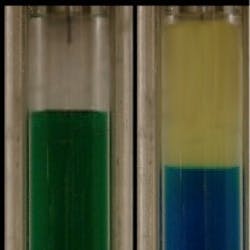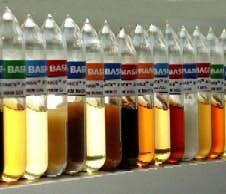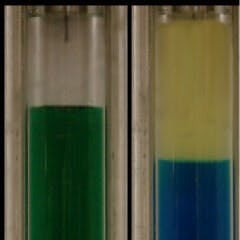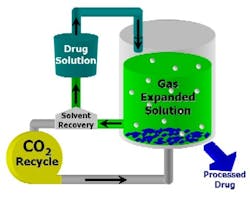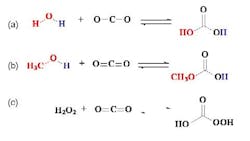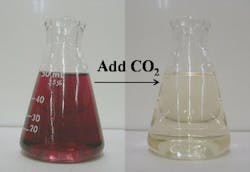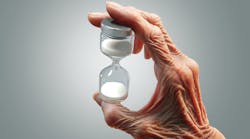The general public first heard about tunable solvents, although they didn’t know it, when supercritical CO2 (scCO2) was first used commercially in caffeine extraction. The food industry now routinely uses scCO2 and other supercritical fluids to extract valuable chemicals from plants [1], and the solvents are being applied in nutraceutical production. Supercritical fluids are so named because they are in the “supercritical” state, above the critical temperature and pressure points at which vapor and liquid phases would be in equilibrium. They are part of a new class of “tunable” solvents, whose properties, including density, dielectric constant and solubility, can be easily varied with changes in pressure or other process conditions. The solvents can even “reverse” activity, and function as an acid and base, as needed, within the same synthesis.Pharmaceutical manufacturers are focusing their evaluation of these new solvents in powder processes [2], which are used to make about 80% of pharmaceuticals on the market. Tunable solvents used in precipitation and collection have been shown to improve particle uniformity and shape. Eventually, however, the fluids could be used outside of powder processing, in virtually every avenue of pharmaceutical manufacturing as a medium for reactions, extractions and separations.Tunable solvents require specialized and expensive equipment, so validation and other issues challenge their use in full-scale drug production today. However, the solvents offer a number of compelling long-term benefits; they are flexible, safe, inexpensive, inflammable and environmentally benign. By selectively precipitating catalysts and products or reactants, they offer advantages in chiral drug synthesis and isolation, and chromatography. They also offer flexibility for synthesis and processing. For example, alcohols can be expanded with CO2 to form reversible alkylcarbonic acids, while CO2-expanded amines yield reversible alkylcarbamic acids, for clean, in-situ acid catalysis. These acid catalysts require no neutralization, eliminating disposal issues associated with salt waste generation.Tunable solvents also offer environmental benefits. Consider phase transfer catalysis (PTC), which has long been used as a technique for the contact of hydrophobic and hydrophilic species and which accounts for more than $20 billion in annual production today [3]. Applying gaseous CO2 to post-reaction PTC mixtures can alter PTC partitioning by up to two orders of magnitude, representing a savings in washwater recovery of over 95% [4], and significant economic savings.As the pharmaceutical industry moves to new and radically different forms of molecules and modes of delivery, the need for new processing and manufacturing techniques is growing at an exponential rate. Tunable fluids applications in pharmaceutical manufacturing will provide solvent media for synthesis as well as processing that meets GMP requirements and offers distinct advantages over conventional methods. This article will examine the promise of tunable solvents, focusing on new synthesis routes, solvent types and advantages in heterogeneous catalytic processes. It will also highlight development projects that are now under way at leading pharmaceutical companies (see Going Green: The Spirit's Willing, But…below).Pharmaceutical applicationsThe advantages of tunable fluid processing have been studied closely, yielding the following modified drug syntheses, each of which has its advantages and weaknesses:
- Rapid Expansion of Supercritical Solution (RESS),
- in which a drug is dissolved in an SCF such as CO
- and then sprayed into a collection chamber. The solvent is then rapidly removed, resulting in well-defined, uniform drug particles. RESS is a simple and effective technique, but is restricted by the limited solubility of drugs in SCFs.
- Gas Anti-Solvent (GAS)
- is another popular technique, shown in
- (
- ). In this case, a gas such as CO
- is added to an organic solution of a desired drug, resulting in the expansion of the organic solvent and the precipitation of uniform drug particles. The precipitation is easily tuned by adjusting temperature and CO
- pressure, allowing close control of particle size and morphology. GAS takes advantage of the organic solvent’s strength coupled with the tunable solvent expandability. However, it requires semi-batch operation.
- Supercritical Anti-Solvent (SAS) and Solution Enhanced Dispersion by Supercritical fluids (SEDS)
- allow for continuous operation and control. In both of these processes, the drug solution is sprayed into the SCF or mixed with the SCF and sprayed into a collection vessel. Nozzle design and inlet stream flow rates can be adjusted to control the process while utilizing the solvent’s tunability.
- Gas eXpanded Liquids (GXLs),
- organic solvents mixed with carbon dioxide gas, which expands their volume by a factor of 10 or more. Nutraceuticals production has moved in the direction of GXLs, by using ethanol cosolvent as a polar modifier with scCO
- . This results in a solvent medium that can combine synthesis and product recovery in a simplified and efficient “one pot” system.
- Near-critical Water (NCW),
- which offers organic solubilities and the potential for reversible acid/base catalysis.
- Organic/Aqueous Tunable Solvents (OATS),
- or water-soluble catalysts (including both aqueous organometallic complexes and enzymatic biocatalysts) that can perform difficult transformations on highly hydrophobic substrates.
Figure 4. Illustrative example of the OATS concept for phase separation. The picture on the left is a 50:50 mixture of tetrahydrofuran (THF) and water. After exposure to 15 bar CO2 pressure (right), the mixture splits into two phases. The top phase contains an organic dye (methyl yellow) while the bottom phase contains an aqueous dye (Blue #1).
We have developed several techniques using CO2 as a “miscibility switch” to turn homogeneous phase behavior “on” and “off,” creating media for performing homogeneous reactions while maintaining the facile separation of a heterogeneous system. Figure 4 (at right) demonstrates this “miscibility switch” with a mixture of water and a water-miscible organic solvent (THF). The high-pressure sapphire tube assembly contains an organic soluble pharmaceutical analog (methyl yellow) and a water soluble catalyst analog (Blue Dye #1). At ambient conditions, the two phases are completely miscible, as shown by the green color. With the addition of 15 bar of CO2, the THF organic phase is expanded, tuning the solvent properties, inducing a complete phase separation shown by the distinct yellow and blue phases.This approach represents an interdisciplinary effort aimed at designing solvent and catalytic systems whereby a reversible stimulus induces a change in the system’s phase behavior, enabling easy recovery of the homogeneous catalysts through simple separation techniques, such as filtering and extraction, which are normally applied to heterogeneous or biphasic catalytic systems. Specific examples include the application of gaseous CO2as a benign agent in GXLs to induce catalytic recycle of:
- Miscible water/organic systems,
- where a catalyst is modified for aqueous solubility;
- Miscible poly(ethylene glycol)/organic systems,
- where a catalyst is modified for PEG solubility;
- Immiscible fluorous/organic liquid/liquid or solid/liquid systems,
- where the catalyst is modified for fluorous solubility;
- Immiscible water/organic systems
- involving phase transfer catalysts.
Dr. Jason P. Hallett is a Research Engineer in the Eckert-Liotta Joint Research Group at Georgia Institute of Technology. He received a B.S. in Chemical Engineering from the University of Maine and a Ph.D. in Chemical Engineering from Georgia Institute of Technology, where he worked on novel methods for homogeneous catalyst recycle.References
- McHugh, M; Krukonis, V., Supercritical Fluid Extraction: Principals and Practice, Butterworth Publishers, Stoneham, Mass., 1986.
- York, P.; Kompella, U.; Shekunov, B., Supercritical Fluid Technology for Drug Product Development. Drugs and the pharmaceutical sciences ; v. 138 M. Dekker, New York, 2004.
- Staks, C.; Liotta, C.; Halpern, M., Phase-Transfer Catalysis: Fundamentals, Applications, and Industrial Perspectives. Chapman & Hall, New York, 1994.
- Xie, X.; Brown, J.; Joseph, P.; Liotta, C.; Eckert, C.,“Phase-Transfer Catalyst Separation by CO2 Enhanced Aqueous Extraction”, Chemical Communications, 2002, 1156.
- Eckert, Charles A.; Liotta, Charles L.; Bush, David; Brown, James S.; Hallett, Jason P. “Sustainable Reactions in Tunable Solvents.” J. Phys. Chem. B 2004, 108, 18108.
- Brown, J.; Gläser, R.; Liotta, C.; Eckert, C.,“Acylation of Activated Aromatics without Added Acid Catalyst”, Chem. Commun., 2000, 1295-1296.
- Chandler, K.; Deng, F.; Dillow, A.; Liotta, C.; Eckert, C., “Alkylation Reactions in Near-Subcritical Water in the Absence of Acid Catalysts,” Ind. Eng. Chem. Res., 1997, 36, 5175.
- Nolen, S.; Liotta, C.; Eckert, C.,“The Catalytic Opportunities of Near-Critical Water: A Benign Medium for Conventionally Acid and Base Catalyzed Organic Synthesis,” Green Chem., 2003, 663.
- West, K.; Wheeler, C.; McCarney, J.; Griffith, K.; Bush, D.; Liotta, C.; Eckert, C.; “In Situ Formation of Alkylcarbonic Acid with CO2” J. Phys. Chem. A, 2001. 105, 3947.
- Xie, X.; Liotta, C.; Eckert, C., CO2-Catalyzed Acetal Formation in CO2-Expanded Methanol and Ethylene Glycol. Ind. Eng. Chem. Res. 2004, 43, 2605.
- Chamblee, T.S., R.R. Weikel, S.A. Nolen, C.L. Liotta, and C.A. Eckert, “Reversible in situ acid formation from beta-pinene hydrolysis using CO2 expanded liquid and hot water” Green Chem., 2004, 6.
- Nolen, S.; Lu, J.; Brown, J.; Pollet, P.; Eason, B.; Griffith, K.; Glaser, R.; Bush, D.; Lamb, D.; Eckert, C.; Liotta, C.; Thiele, G.; Bartels, K.,“Olefin Epoxidations Using Supercritical Carbon Dioxide and Hydrogen Peroxide Without Added Metallic Catalysts or Peroxy Acids,” Ind. Eng. Chem. Res., 2002. 41, 316.
- West, K.; Hallett, J.; Jones, R.; Bush, D.; Liotta, C.; Eckert, C. "CO2-Induced Miscibility of Fluorous and Organic Solvents at Ambient Temperatures." Ind. Eng. Chem. Res., 2004. 43, 4827.
- Lu, J.; Lazzaroni, M.; Hallett, J.; Bommarius, A.; Liotta, C.; Eckert, C. “Tunable Solutions for Homogeneous Catalyst Recycle.” Ind. Eng. Chem. Res. 2004, 43, 1586.
